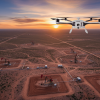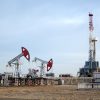Trillions of dollars worldwide are invested annually in new construction projects. Despite the best laid plans, construction projects often run over schedule. This can result in lost revenue and other negative financial implications. While some delays in construction, such as weather conditions, may be unavoidable, other factors leading to delays can be alleviated or even eliminated with enhanced construction site inspection. With automated monitoring, site inspection has never been safer, easier or more effective.
Fast, accurate decision-making
Large construction projects typically include a general contractor and multiple subcontractors – not company employees. Keeping everyone engaged and moving in the same direction to meet the designated timeline requires management and oversight. However, decision makers and management, particularly in the age of Covid-19, may not even be onsite to perform an inspection and ensure workers are on task.
Autonomous inspection with robots and drones enables remote monitoring of construction sites in real time. Off-site decision makers can stay safe, and not in the dark, forced to make crucial decisions based on hearsay. Instead, they have a clear picture of what is actually happening at the construction site.
Besides providing visuals of a construction site, the tools that enable an autonomous inspection can also create data and reports, analyze visual data, and deliver actionable insights and reports. A Mexican energy infrastructure company that uses drones to automate inspections develops weekly reports that include information such as percentage of work completed and the amount of concrete poured.
When decision makers have access to both data and images, they’re able to gain deeper insights and make decisions more quickly, which enables them to take action that can lead to cost savings and help keep the work on schedule. Remote monitoring can be as effective as onsite inspection.
Allowing all the key players easy access to relevant reports can also help reduce downtime.
Safety and Compliance
Increasing safety is always top of mind for management as construction sites are dangerous. According to the Bureau of Labor and Statistics, there are nearly 150,000 construction site accident injuries annually, and OSHA notes one out of 10 construction personnel is injured annually.
Besides the human costs that arise from construction site accidents, injuries impact workflow, scheduling, and costs. If an injured employee is absent from the worksite, their place must be taken by someone else or it goes unfilled. Both circumstances are time consuming – either a new person has to be recruited and trained or the rest of the team has to make up for the missing labor while they’re shorthanded. The costs also extend to compensating the injured party. compensate
Meanwhile, OSHA reports that for every $1 invested in a safety and health program, businesses can realize $4–$6 in savings.
Using drones and robots for a construction site inspection improves safety since it lessens the potential for accidents as it keeps employees out of potentially harmful areas. In addition, those areas of a construction site which may be difficult or dangerous to access and might otherwise be overlooked or rushed through can be easily and safely inspected. This can help ensure construction sites comply with relevant rules and regulations and employees and equipment are kept safe.
And, non-compliance can be costly. In 2018, the construction industry was cited by OSHA 25,294 times, resulting in penalties of nearly $74 million.
Besides the financial penalty and potential safety issues of non-compliance, inspectors can enforce a work stoppage until a site meets the required standards. Losing even one day on a construction site can be costly. A US downstream company reports that every day they are closed due to construction delays they lose $60 million. The company is planning to automate monitoring, which will enable them to avoid shutdowns.
Lastly, visuals and data obtained when performing site inspections via remote monitoring with drones and robots can be stored and shared with regulators as proof of compliance.
Contractor Accountability
Two talents of a good manager are holding employees accountable and inspiring them to work to their full capabilities.
With remote monitoring of a construction site, management can gain a clear picture of employee productivity. Are people working when they’re on the clock, or are they milling about checking their phones and socializing? Employees may need to be reminded of their responsibilities and expectations. A slow start may also indicate that the schedule or workflow needs to be adjusted.
Equipment and supplies can also be tracked via automated inspection. Drones, which allow for more frequent and accurate monitoring, can collect visual data to certify that supplies are properly stocked, safely secured. and used appropriately. Using up, or improper use of supplies can cause the schedule to go awry, and be costly.
Equipment and or critical parts can get lost or stuck at the bottom of piles. Construction site inspections done with drones and robots produce visual data that can be reviewed, so lost equipment may be located, thus saving time and money.
Objective reporting via an in-person site inspection can be a challenge due to the size and number of different building phases at a construction site. By the time the inspection is complete, recency bias may set in, leading inspectors to focus on what’s in front of them or most glaring and neglecting issues which at first glance seem minor.
With remote monitoring of construction sites nothing slips through the cracks. Those reviewing the visual data can be objective because they are not influenced by time or other outside factors.
Automated inspection at construction sites enables decision makers to make quick decisions based on accurate visual data, increases safety, and improves accountability. Each of these benefits positively impacts a construction project’s schedule and therefore improves the bottom line. After all, time is money.





